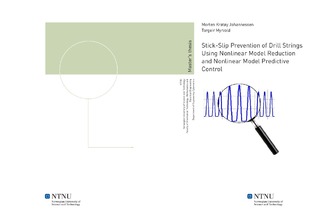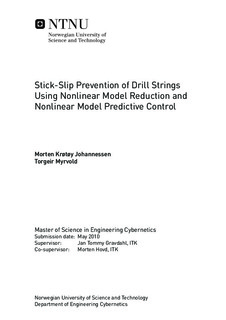| dc.contributor.advisor | Gravdahl, Jan Tommy | nb_NO |
| dc.contributor.advisor | Hovd, Morten | nb_NO |
| dc.contributor.author | Johannessen, Morten Krøtøy | nb_NO |
| dc.contributor.author | Myrvold, Torgeir | nb_NO |
| dc.date.accessioned | 2014-12-19T14:02:01Z | |
| dc.date.available | 2014-12-19T14:02:01Z | |
| dc.date.created | 2010-09-03 | nb_NO |
| dc.date.issued | 2010 | nb_NO |
| dc.identifier | 347977 | nb_NO |
| dc.identifier | ntnudaim:5343 | nb_NO |
| dc.identifier.uri | http://hdl.handle.net/11250/259796 | |
| dc.description.abstract | The main focus of this thesis is aspects in the development of a system for prevention of stick-slip oscillations in drill strings that are used for drilling oil wells. Stick-slip is mainly caused by elasticity of the drill string and changing frictional forces at the bit; static frictional forces are higher than the kinetic frictional forces which make the bit act in a manner where it sticks and then slips, called stick-slip. Stick-slip leads to excessive bit wear, premature tool failures and a poor rate of penetration. A model predictive controller (MPC) should be a suitable remedy for this problem; MPC has gained great success in constrained control problems where tight control is needed. Friction is a highly nonlinear phenomenon and for that reason is it obvious that a nonlinear model is preferred to be used in the MPC to get prime control. Obviously it is of great importance that the internal model used in the MPC is of a certain quality, and as National Oilwell Varco (NOV) has developed a nonlinear drill string model in Simulink, it will be useful to check over this model. This model was therefore verified with a code-to-code comparison and validated using logging data provided from NOV. As the model describing the dynamics of the drill string is somewhat large, a nonlinear model reduction is needed due to the computational complexity of solving a nonlinear model predictive control problem. This nonlinear model reduction is based on the technique of balancing the empirical Gramians, a method that has proven to be successful for a variety of systems. A nonlinear drill string model has been reduced and implemented to a nonlinear model predictive controller (NMPC) and simulated for different scenarios; all proven that NMPC is able to cope with the stick-slip problem. Comparisons have been made with a linear MPC and an existing stick-slip prevention system, SoftSpeed, developed by National Oilwell Varco. | nb_NO |
| dc.language | eng | nb_NO |
| dc.publisher | Institutt for teknisk kybernetikk | nb_NO |
| dc.subject | ntnudaim | no_NO |
| dc.subject | SIE3 teknisk kybernetikk | no_NO |
| dc.subject | Reguleringsteknikk | no_NO |
| dc.title | Stick-Slip Prevention of Drill Strings Using Nonlinear Model Reduction and Nonlinear Model Predictive Control | nb_NO |
| dc.type | Master thesis | nb_NO |
| dc.source.pagenumber | 107 | nb_NO |
| dc.contributor.department | Norges teknisk-naturvitenskapelige universitet, Fakultet for informasjonsteknologi, matematikk og elektroteknikk, Institutt for teknisk kybernetikk | nb_NO |

